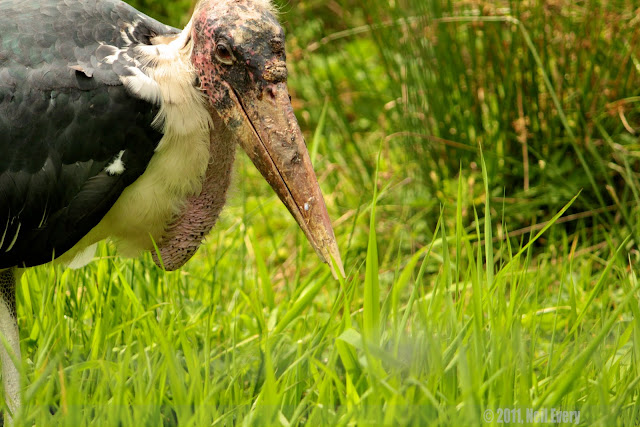Welcome to Part II of the July long weekend safari adventure at the Greater Vancouver Zoo.
Not far from the Giraffe paddock something very large was picking its way through the grass. There was a Blue Heron nearby that was dwarfed by this creature and as it came closer, we wondered if it had had an accident of some kind. For all intents and purposes, this bird looked like it had been torched and was in serious need of some cosmetic surgery.
This is a Marabou Stork and, contrary to his appearance, he is totally fine. They all have this bare, scarred look. It's hard to tell from the above photo but this bird was HUGE. According to wikipedia they grow up to 150cm in height, weigh 10-18 lbs and have a wingspan of at least 3.5m!
Guess who?
This an African White Rhino and there are two subspecies, the Northern and the Southern. Given that there are only known to be seven Northern White Rhinos in existence, all of whom are in captivity, I'm guessing this one is a Southern White Rhino. At 40yrs old he is the oldest inhabitant of the Vancouver Zoo.
From the same continent are these African Buffalo which, due to their unpredictable nature, have yet to be domesticated. In fact they're so aggressive they've been known to take on lions as seen in this youtube video that to date has garnered a staggering 62 million views!
Just as aggressive, although you'd never think it from the below picture, is the Hippo. Two fascinating facts: 1) Despite weighing between one and half to 3 tonnes, they can easily outrun a human and over short distances can hit a speed of 30 km/hr. 2) Hippos' closest living relatives are Cetaceans - i.e. Whales.
Speaking of animals that can outrun humans...
This little guy will grow up to be one of the fastest Equines (70 km/hr) on the planet. The Kulan originates in Asia and following a successful conservation effort were recovering well until a few years ago when poaching made an aggressive return. Kulan are now on the critically endangered species list with less than a thousand left in the wild.
In an even worse situation is the Scimitar Horned Oryx. Hunted for its horns, the Oryx once occupied the whole of the Sahara and are considered extinct in the wild. There has not been a confirmed sighting of one in the wild in over 15yrs... There are believed to be over 2,000 Oryx in captivity.
This Arctic Wolf must be one of the few Vancouverites who actually doesn't mind the cooler summer temperatures this year.
This crazy looking ball of fun didn't seem to have an identification sign beside his enclosure. Is it a Hyena perhaps? Bragging rights for anyone who can identify it!
Contrary to popular belief, Camels store neither water nor beer in their humps. It's actually a fat reserve. Capable of surviving without water for months, when Camels eventually stop for a drink they can consume a staggering 57 liters in one sitting!
This Black Burro was one of the most laid back animals of the day. Whereas this Emu...
Is a perfect set-up for Part III. Coming soon...!
Until next time folks.













No comments:
Post a Comment